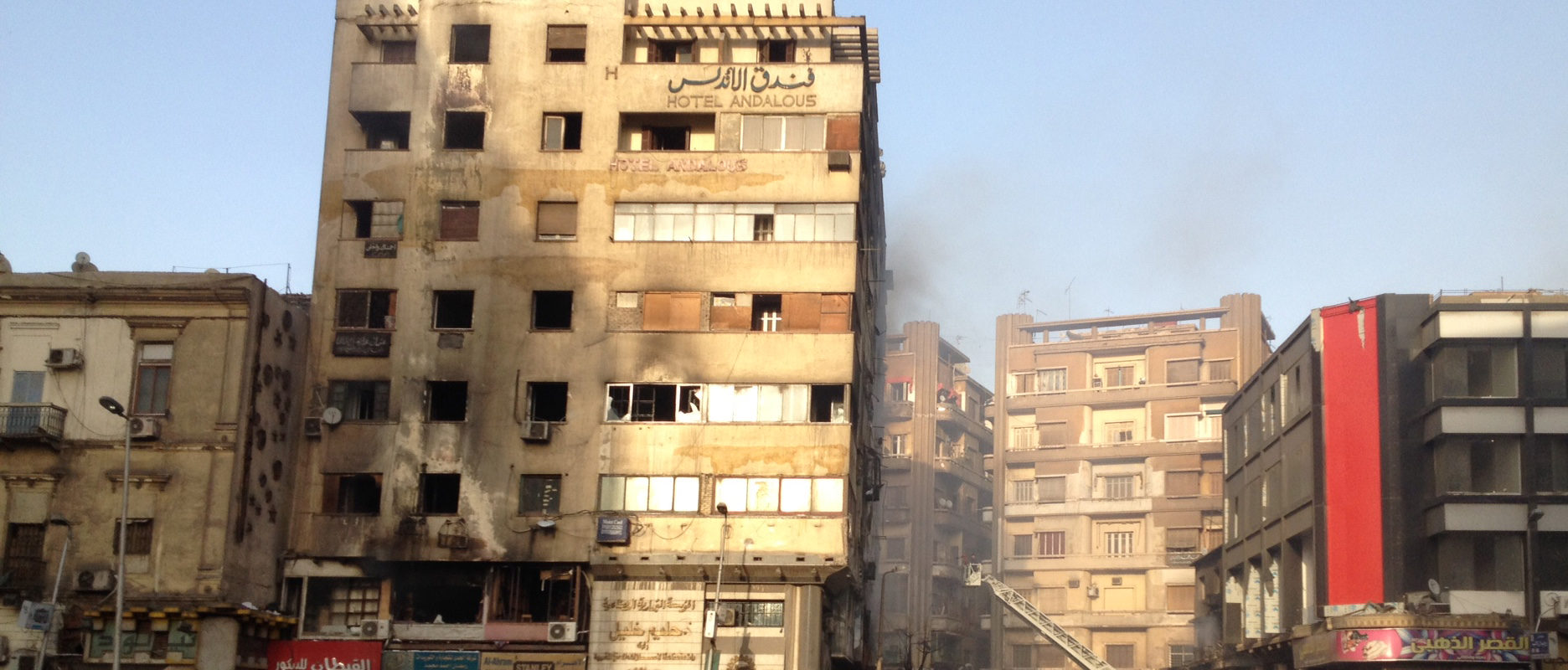25 June 2016
Attaba is Cairo’s most popular bazaar. Just east of downtown, the sprawling network of alleys and squares offers thousands of stores and street sellers. It takes skill to navigate the crowds; everyone has a shopping bag—or two or three—in their hands, or on their heads, trying to edge their way through the narrow spaces that motorbikes, donkey carts, and mini-trucks manage to squeeze through. In Attaba, you can find gilded mirrors on shaded passages, mismatched toilet pieces meticulously lined up on the sidewalk, saucy lingerie hanging on street corners, dusty shop windows full of porcelain statuettes, fences lined with SpongeBob party favors, and toiletries sold by chain-smoking hawkers on foldout tables that spill into the traffic. There are yellowed, early 20th century arcades that now accommodate the city’s best-stocked hardware stores. There is a garbage-filled road of faux flower shops intersected by an even narrower one, whose ramshackle appearance belies the elegant wedding arrangements and invitations behind glass; there are wholesale sellers of mannequins and more shoes than I have ever seen in my life. When I am in the thick of it, I can wander for hours; by the time I get home, my hands are black, my brow sunburned. As exhausted as I get from crisscrossing Cairo’s busiest quarter, I always come back for more.
On Sunday, May 8 at 11:30 at night, a guesthouse on the top floor of a six-story building on Attaba’s main square caught fire. The blaze at Al-Andalous Hotel spread to neighboring buildings. Three died running into their shops to retrieve their wares; more than 70 were injured. Over 240 stores, 70 apartments, and 40 warehouses were charred.
My eyes watered the next afternoon as I walked down Al-Bosta Street toward the book market. First I saw vendors running back and forth, carrying merchandise on their backs, away from the fire. Then, a peculiar formation—dozens of black-uniformed police officers locked arms, forming a ring to block the road from the usual torrent of cars, motorbikes, minibuses, buses, and taxis. In Attaba Square itself, the hundreds of clothing sellers were gone, and emergency vehicles were in their place. A fire truck ladder reached up several stories, its hose spraying a blackened building.
Smoke filled the sky. Around the corner, many other shops operated at a normal pace. I bought an orange Fanta from a kiosk across the road, and the shopkeeper told me that 18 buildings burned. These were stores I had frequented, where I might have bought the red wall clock in my living room or had compared the prices of curtain rods. I was sad. I had nightmares.
I kept bringing Attaba up in conversations with friends, but few had heard about the incident. Photos of firefighters had been above the fold in the day’s papers, but other disasters across the country (like the crash of EgyptAir flight 804 two weeks later) eclipsed Attaba’s misfortune. So I returned a week later to assess the damage. It seemed that little had changed, besides the area around the hotel and its square being cordoned off. The rest of Attaba was busier than usual. Ramadan was just two weeks away, and everyone was checking items off their shopping lists.
* * *
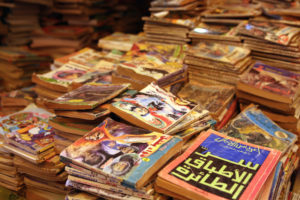
I have been getting lost and found in Attaba on and off for ten years. I must have discovered it on the way to the grand avenue of Mohammed Ali Street (which has a great selection of guitar and oud shops) or trying to navigate toward Ezbekiya Gardens (whose vintage book market has been a favorite haunt of mine). Friends are surprised when I tell them of my love affair with Attaba’s endless possibilities, probably because some have never been there and would not know the lighting district (phony crystal chandeliers on grubby sidewalks!) from the furniture ward (purple leopard print wraparounds, also on grubby sidewalks!). And few expats manage its labyrinth, not daring to explore streets that Google Maps inaccurately render. For me, Attaba is a great place to get a cheap, durable shower curtain or a novelty doormat; it is also a marketplace of inspiration.
Attaba’s influence is apparent in Cairo’s contemporary art scene. Huda Lutfi, who most recently held a show at Dubai’s prestigious gallery The Third Line, is known for mixed media pieces composed of pickings from flea markets and antique dealers. Some works feature mannequins or dolls, commenting on downtown storefronts that are filled with more mannequins than seem possible to fit in a glass window. Lutfi’s creations challenge one to rethink what is refuse and what is useful, in the way that much of the markets in the city do; they also capture the commercialism of everyday life.
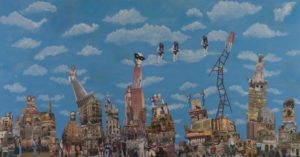
Similarly, the artist Hany Rashed has been inspired by the endless markets of Attaba. For his 2013 show Toys, he created flat, three-dimensional objects akin to large action figures, the result of experiments of heating and stretching plastic. His Toys consisted of the people and things of everyday Cairo: policemen, shoppers, minibuses, and tok toks.[1] In the art gallery’s main room, he recreated a busy pedestrian scene. The concept for Toys emerged from Rashed’s many trips to Attaba, where he had bought plastic kid’s kitsch and then researched its fabrication, from the products themselves to their clear plastic packaging and poorly printed labels. Rashed went on to package some of his Toys; the labels provide the name of the gallery and its address, as if it were a second-rate import-export company rather than a respected purveyor of contemporary art. “I also added China as the country of origin, although I made them myself in Egypt,” he says. “All the materials were from China, so I thought I’d go all the way.”[2] Inspired by the plasticization of the city, his Toys reclaimed Attaba’s products and brought the low-class experience of shopping in the bazaar into a highbrow gallery.
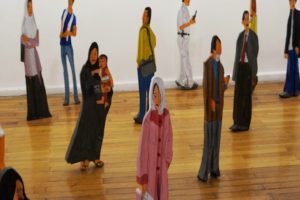
The toys on sale in Attaba may inspire art, but the art on sale in Attaba is something else entirely, paintings of corny European landscapes or portraits of Caucasian maidens in fake gold frames, displayed next to knockoff French furniture. I came across these made-to-order antique shops when I went hunting for a makeup case for my girlfriend last summer. A bric-a-brac saleswoman assured me I could find a makajiyat case down the road in the Jewish Alley, where the once robust community had lived and worshipped since the 10th century. I didn’t find a case, but I passed Jewish schools and temples that have long since been shuttered, including the refurbished synagogue over which Maimonides once presided.
In the early 20th century, architects created grand shrines to consumerism, like the Tiring Building. The domed department store, built in 1913, sticks out from Attaba’s humbler boutiques like a pop-up book. Cairo’s finest department stores once sold goods as lavish as Europe’s own. Most were nationalized in the 1950’s, after the Free Officer’s movement ousted the king.
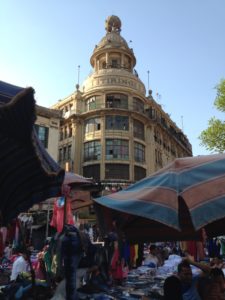
To even approach Tiring, one must weave between scores of tables and shops. This square is perhaps the most jam packed in the city, with several thousand people haggling or window-shopping at this intersection alone. Each little alley off it holds out whole new varieties of goods, like a passage of trellised room dividers with cherry varnish or a backstreet of neon-colored sneakers. One salesman stands on his table and yells about white undershirts into a megaphone with heavy reverb, a hip hop artist performing to a full crowd.
On the ground floor of the Tiring building is a store called Mecca, where twenty-foot tall windows of floor to ceiling mannequins are dressed in the season’s latest women’s jackets and children’s clothes (not Ferragamo, mind you, but knockoffs). I circle the building, guessing how to get to the top. Through an extensive arcade of jewelry, watches and eyeglasses, I discover a back entrance between several belt stores. I wander up the spiral staircase, black from use, and pause to enjoy the intricate metalwork in the stairwell, and the broken elevator’s cage, which might be as old as the building itself. Cigarette butts are littered on nearly every step. I continue up, past many more leather shops.
Kids play soccer on the third level. The floor is covered with takeout containers, soda bottles, and feline excrement. An elderly caretaker, watching television and drinking tea, manages the bathroom there. I cross the hall and see the outline of the vaulted ceiling atop a shop selling what looks like prom dresses (though more likely they are wedding dresses). I amble up another set of windy staircases.
The roof is quiet. The market five floors below seems like a mile away. A 20-year-old tailor is drinking a non-alcoholic beer under a canopy. He waves me over and offers me a sip. He brushes off a chair and pulls it into the shade for me. The young tailor wants to take me to the top of the grand dome that is slightly lopsided, but I tell him I’m scared of heights, that this view is plenty nice for me.
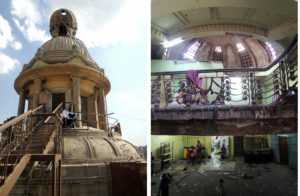
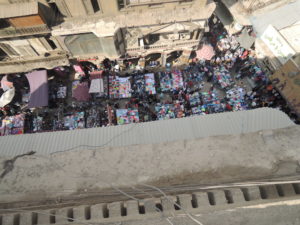
We sit in silence for a few minutes. Then he walks toward the edge of the roof and picks up a charred paper receipt that had blown over. He points to a row of buildings in a square that were caught in the blaze. I ask him if he was here during the fire or whether he was off, as that day was a national holiday. He shrugs. He tells me he never gets a vacation.
It would be easy to describe the experience of the Tiring Building as an indication of Egypt’s decline from the colonial splendor or to extricate this tailor’s experience as that of all Egyptians. But I prefer to marvel at the fact that, over a century since its construction, this towering monument still contains five stories of operating shops. Though the clientele and products have changed in the intermediate years, it remains a temple of capitalism. And it is still the tallest building in the neighborhood.
* * *
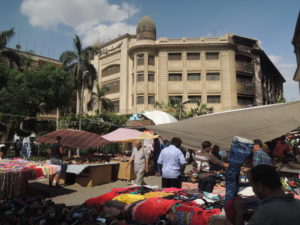
The burning of Attaba Square, one of many recent fires in the city, spurred speculation of an arson campaign. First the outer edge of the gilded Sednaoui Department Store, another hundred-year-old shopping center a couple of blocks from Attaba Square, caught fire on May 2, scorching a wall. That week, a slew of other fires flared across the country: a Tanta apartment, the grass outside a train station in Maghagha, one of Port Said’s ports, a train loaded with fuel in Minya, 30 acres of wheat in Sharqiya, four acres of sugar cane in Beni Suef, six homes in Sohag, two apartments in Suez, and a tourist yacht in Hurghada.[3] On May 8, air conditioners in the Giza security directorate caught fire, the very day that Al-Andalous Hotel sparked Attaba’s flames. A few days later, the historic market of Ghouria also burned. On June 3, a fire in Misr Company for Sound, Light and Cinema Thursday destroyed Al-Nil Studio, a historic recording space filled with archival material.
A spokesman for the Ministry of Interior said that the cause of Attaba’s tragedy was an electrical fire caused by a short circuit.[4] But some claim the circumstances were fishy: the city’s central fire station is across the adjacent flyover, yet it is said that it took a couple hours for emergency workers to respond. It was also a Sunday night and the country’s spring holiday, a day off for much of the market, otherwise the toll would have been higher. The prominent businessman Naguib Sawiris, always the showman, blamed the Muslim Brotherhood.[5] Others claim negligence on the part of the government, or a concerted campaign to clear out informal commerce networks and make way for new retailers.
Few of the conspiracy theorists note the obvious: the first week of May was unseasonably hot, edging past 100 degrees. Neither the power grid nor the residents were prepared for such a scorcher.
The fears about fires touch on a bigger set of concerns. The infamous 1952 Cairo fire signified a break with the colonial past, as looters ransacked much of the capital’s British and foreign interests. On that so-called Black Saturday, iconic institutions of colonialism, like the Shepherd Hotel not far from Attaba, burned to the ground. The recent fires are not on the same scale of size or perniciousness as the 1952 blaze, but the events of a half-century ago are certainly a reminder of how rapidly a fire can get out of control in the wider, political sense.
Cartoonists have often used the metaphor of fire—uncontainable, searing, and destructive—to emphasize anxiety regarding uncontrollable trends, like rising prices for fuel and food. And since the string of blazes, cartoonists have been drawing about the conflagrations in Attaba and elsewhere. Four cartoons for the independent Al-Masry Al-Youm newspaper offer a variety of perspectives.
Amro Selim, a veteran cartoonist who never hesita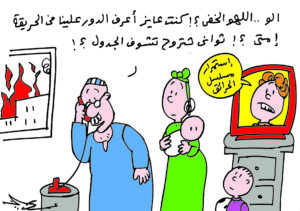 tes to crack a joke amid tragedy, drew a straightforward gag in his signature, simplistic style. “Hello, Mr. X,” says a man beside his family while a bright red fire burns outside his window. “I wanted to know when the fire would reach us. Need a second to look at the schedule?” Selim speculates that these are premeditated acts of arson.
tes to crack a joke amid tragedy, drew a straightforward gag in his signature, simplistic style. “Hello, Mr. X,” says a man beside his family while a bright red fire burns outside his window. “I wanted to know when the fire would reach us. Need a second to look at the schedule?” Selim speculates that these are premeditated acts of arson.
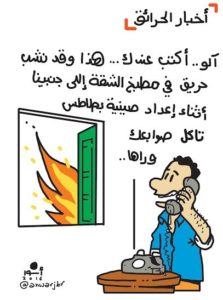 Anwar also caricatured a man making a call. “Hi. Take this down,” says the everyman. “A fire has broken out in the kitchen in the apartment beside us, during the preparation of a really delicious potato dish.” In poking fun, Anwar suggests that the causes of the fires are innocuous and relate to individual carelessness. Anywhere potatoes are being fried tonight poses a risk.
Anwar also caricatured a man making a call. “Hi. Take this down,” says the everyman. “A fire has broken out in the kitchen in the apartment beside us, during the preparation of a really delicious potato dish.” In poking fun, Anwar suggests that the causes of the fires are innocuous and relate to individual carelessness. Anywhere potatoes are being fried tonight poses a risk.
Their colleague Makhlouf addressed the conspiracy theorists directly and drew masked terrorists cracking jokes. (Makhlouf has often used these two characters to represent amateurish ISIS or Al-Qaeda extremists.) “Never mind about burning it now,” 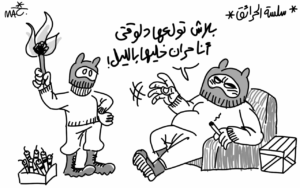 says the boss terrorist on the couch, speaking to a younger operative who holds matches over a carton of dynamite. “I’m feeling hot—let’s do it in the evening.” According to Makhlouf, these are not necessarily acts of terrorist arson, but the series of fires is terrorizing the country.
says the boss terrorist on the couch, speaking to a younger operative who holds matches over a carton of dynamite. “I’m feeling hot—let’s do it in the evening.” According to Makhlouf, these are not necessarily acts of terrorist arson, but the series of fires is terrorizing the country.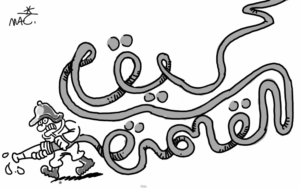
In another cartoon by Makhlouf, a fireman moseys across the frame, tangled hose in hand. The hose spells out, “Cairo Fires.” Walking not running, the bumbling firefighter insinuates that government failures have hastened calamity.
* * *
It is midafternoon on a Friday, usually a quiet time for the city. I hail a taxi to Attaba.
“The most difficult neighborhood of Cairo,” says the driver. “At any time, morning or night, there’s traffic.” Normally, I wouldn’t quote a taxi driver in an article, but who is a better expert on traffic?
The gridlock tends to begin blocks away from Attaba, in Opera Square, where the ostentatious theater was located from 1869 until it burnt down in 1971. Amid a symphony of honks and the punctuation of a jackhammer, I exit the cab.
I cross three lanes of gridlocked cars, sidestepping motorcycles splitting through the lines of traffic. Young boys unload bags onto a pavement lined with fake flowers and pastel comforters, before a lineup of minibuses with navigators sticking their heads out of the passenger windows and urging passersby to hop on. On the sidewalk in front of the historic post office, shoes, suitcases, neon colored toys are meticulously spread out. A sandwich cart in the middle might offer a quick snack en route to more shopping.
Today I don’t need a new wallet. I am not here for socks or sandals (neither plastic nor leather); no stuffed animals, track pants, or bifocals for me. I want to see how the center of Attaba looks three weeks after the fire.
I squeeze past shoppers on Al-Rawiei Street, past tables on the pavement of bags, shoes, watches, gallabiyas, little dresses for children or dolls, bras, cargo shorts, glittery shirts, knock-off roller bags, jeans, pink checkered flannel shirts, sweatpants, tuxedos, graphic t-shirts, and more jeans splayed on the floor and on tables. The tables go on and on, interrupted by the occasional orange juice stand. Some tables offer nail clippers, jewelry and peelers; on others are stacks of plastic-wrapped button-downs, socks, boxer briefs, pajamas, ersatz Zara polos or Burberry scarves. Behind the mannequin in a soccer jersey and a couple of umbrellas are brick and mortar perfume stores on the ground floor of discolored art deco storefronts. A seller wears a cardboard box on his head to shield him from the midday sun. A juice man pours another a glass of hibiscus for a customer. Next to the koshary cart, a merchant beats the dust off of his suitcases.
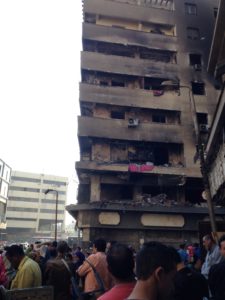
At the edge of the sidewalk, five young policemen in black uniforms stand before barriers labeled Cairo Traffic. They block off the immediate site of the fire, which is still closed to pedestrians. (“Two for one, two for one,” a megaphone blares.) Usually the square is just as filled with shoppers and sellers as anywhere else. Today the shops on that midan are shuttered, and many of the buildings are covered with black soot. But sweets, sandals and t-shirts are on sale around each and every corner, steps from sidewalks covered with burnt out debris. (“Do you want a knife or what?” the kitchen salesman at the next table asks his customer.) Laid out on a blanket on a table just across are summer hats, including a straw fedora I would buy if the 10-year-old retailer could find me a bigger size.
The Al-Andalous Hotel’s burnt out edges look the same as the day after the fire. The windows are gone, the dust colored exterior walls black. But five doors down, an upmarket home store has reopened. I ask the shopkeeper whether he believes it was an electrical fire. “Only God knows!” he says, throwing up his hands.
To get a closer look at the ruins, I walk the opposite direction and then cut back on a parallel street full of tables covered with shoes, perhaps tens of thousands of shoes, on wood tables with table clothes, barely enough room for pedestrians to ogle the miscellany. Each of Cairo’s 20 million residents needs at least a pair.
As I take the long way and pass more shoe shops to reach the edge of the fire’s path, I realize that its source will never be properly investigated. If the cause of the flames that charred the Royal Cairo Opera House four decades ago has never been uncovered, why would a fire in a poor neighborhood be properly inspected? I duck into a busy café. The cheap coffee tastes burnt.
[1] See: Surti Singh. “Historical Realities of Concept Pop: Debating Art in Egypt,” Jadaliyya. 17 December 2014. http://www.jadaliyya.com/pages/index/20305/historical-realities-of-concept-pop_debating-art-i
[2] Medrar TV. “Toys.” 14 July 2014. https://www.youtube.com/watch?v=UTfiGsKUxvs
[3] Mahmoud Al-Waqah. “From the Samalout Train to Attaba, 20 Fires in Egypt During 10 Days (Timeline),” Al-Masry Al-Youm, 11 May 2016.
http://www.almasryalyoum.com/news/details/945327
[4] Amany Sobhy. “Interior [Ministry] Discloses Cause of the Attaba Fire,” Al-Wafd, 9 May 2016.
http://alwafd.org/ميـديا/1168622-شاهد-الداخلية-تكشف-سبب-حدوث-حريق-العتبة
[5] Ramadan Al-Sherbini. “Mystery Blazes in Cairo Fuel Arson Claims,” Gulf News, 17 May 2016. http://gulfnews.com/news/mena/egypt/mystery-blazes-in-cairo-fuel-arson-claims-1.1829419

